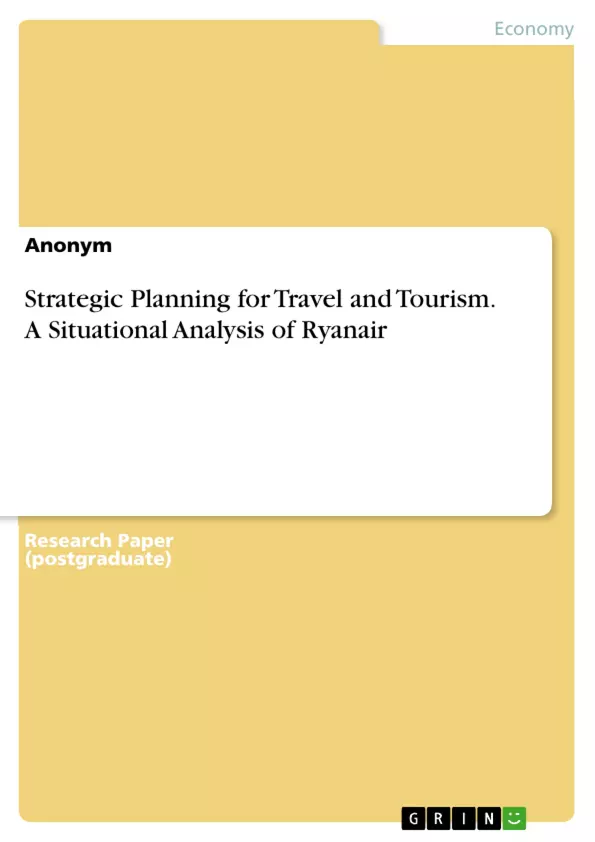The purpose of the report is to undertake a situational analysis of Ryanair. The situational analysis will be undertaken through the use of models and frameworks such as STEEPLE, Porter's Five Forces model, McKinsey’s 7S framework and SWOT analysis. Thereafter, the challenges facing Ryanair will be explored. Secondly, the report will provide a logical and clear strategic plan that is linked to the findings of the situational analysis. The strategic plan will be developed to assist Ryanair to keep a competitive advantage and achieve the strategic objectives of the company.
Ryanair is an Irish low-cost airline that was founded in 1984. In the 1st year of operation of the airline, over five thousand customers travelled between Ireland and London. By 1989, over 600,000 passengers were travelling via Ryanair. In the initial 4 years of the operation of the company, the company made a combined loss of £20 million. The management of the company changed in 1990 when Michael O’Leary was appointed as the CEO. O’Leary made several changes to Ryanair thus adopting a no-frills operational model as well as the reduction of the routes. In the next 6 years, the fleet was increased to over 21 leading to an increase in customers due to the low prices. Following the deregulation of EU air transportation regulations that restricted the low pricing policy of the firm, the firm took advantage and was able to increase its profitability and market share in low-cost airlines.
Inhaltsverzeichnis (Table of Contents)
- Task 1
- Introduction
- Summary of Ryanair
- Purpose of the Report
- Situational Analysis of Ryanair
- A. Analysis of Macro Environment Using STEEPLE
- B. Analysis of the Micro Environment Using Porters Five Forces
- C. Analysis of the Internal Environment of Ryanair Using Mckinsey 7s Framework
- D. A SWOT Analysis
- E. Outline of the Key Challenges Facing Ryanair
- Task 2
- 1. Development of Objectives
- 2. A Recommended Strategic Option and Supporting the Rationale for the Strategic Choice
- 3. An Action Plan of How Ryanair Will Implement the Chosen Strategy
- 4. Recommendations on How the Organisation Should Monitor the Performance of the Strategic Plan
- 5. Conclusion
Zielsetzung und Themenschwerpunkte (Objectives and Key Themes)
This report aims to conduct a comprehensive situational analysis of Ryanair, a leading low-cost airline, utilizing frameworks such as STEEPLE, Porter's Five Forces, McKinsey's 7S, and SWOT analysis. It then proceeds to develop a strategic plan to help Ryanair maintain a competitive advantage and achieve its objectives.
- Situational analysis of Ryanair
- Identification of key challenges facing Ryanair
- Development of strategic objectives for Ryanair
- Recommendation of a strategic option for Ryanair
- Implementation plan for the chosen strategy
Zusammenfassung der Kapitel (Chapter Summaries)
- Task 1: Situational Analysis of Ryanair This chapter provides an overview of Ryanair's history and business model. It then delves into a detailed situational analysis using various frameworks to assess the macro, micro, and internal environments of the airline. The chapter concludes by identifying key challenges facing Ryanair.
- Task 2: Strategic Planning This chapter focuses on developing a strategic plan for Ryanair. It outlines the company's objectives, recommends a strategic option, and provides an action plan for implementing the chosen strategy. It also includes recommendations for monitoring the performance of the strategic plan.
Schlüsselwörter (Keywords)
This report focuses on strategic planning for the travel and tourism industry, specifically examining the case of Ryanair. Key concepts include situational analysis, STEEPLE framework, Porter's Five Forces, McKinsey 7S framework, SWOT analysis, strategic objectives, strategic options, and implementation plans. The report also explores challenges related to low-cost airlines and the impact of factors like Brexit and environmental regulations.
- Quote paper
- Anonym (Author), 2022, Strategic Planning for Travel and Tourism. A Situational Analysis of Ryanair, Munich, GRIN Verlag, https://www.grin.com/document/1308622



